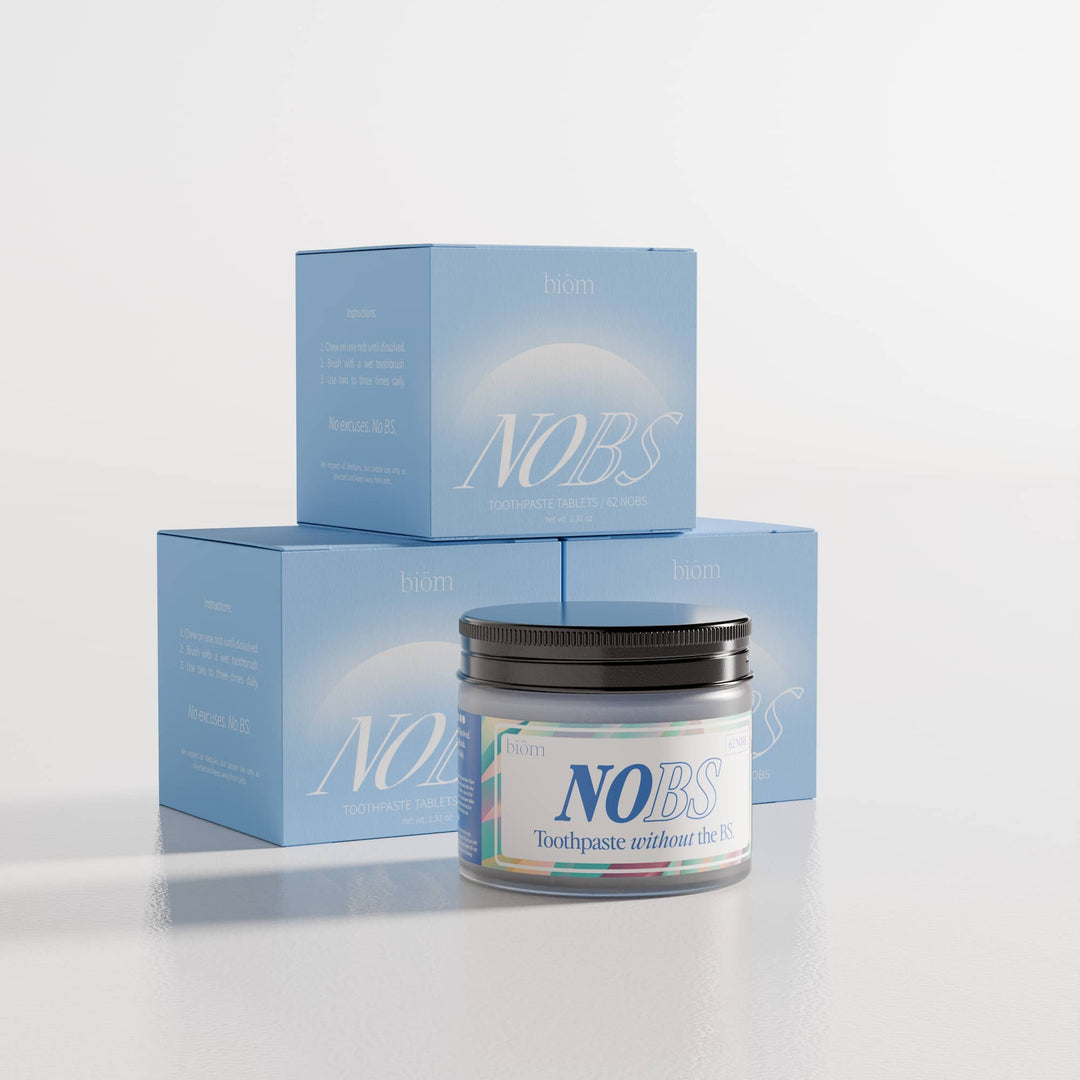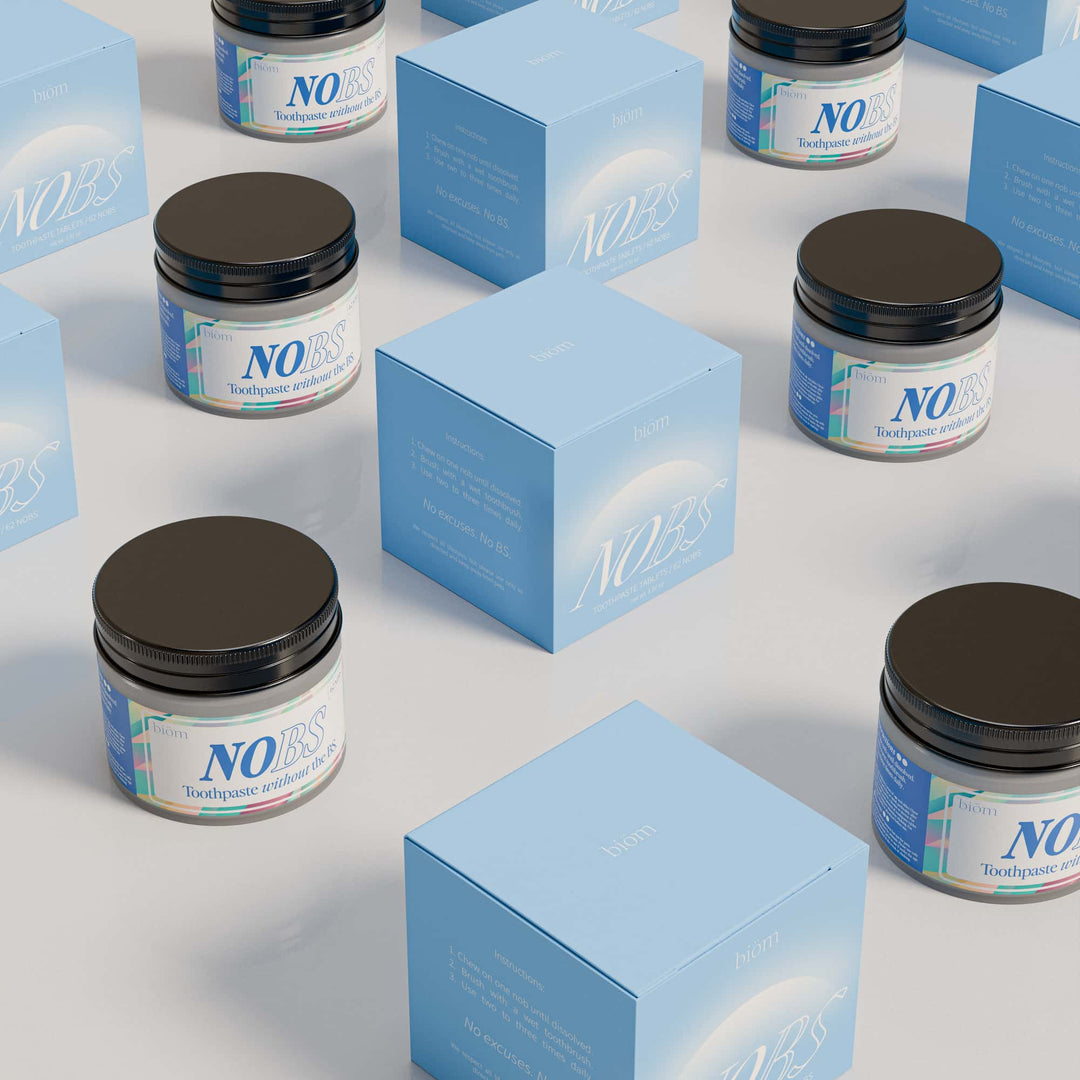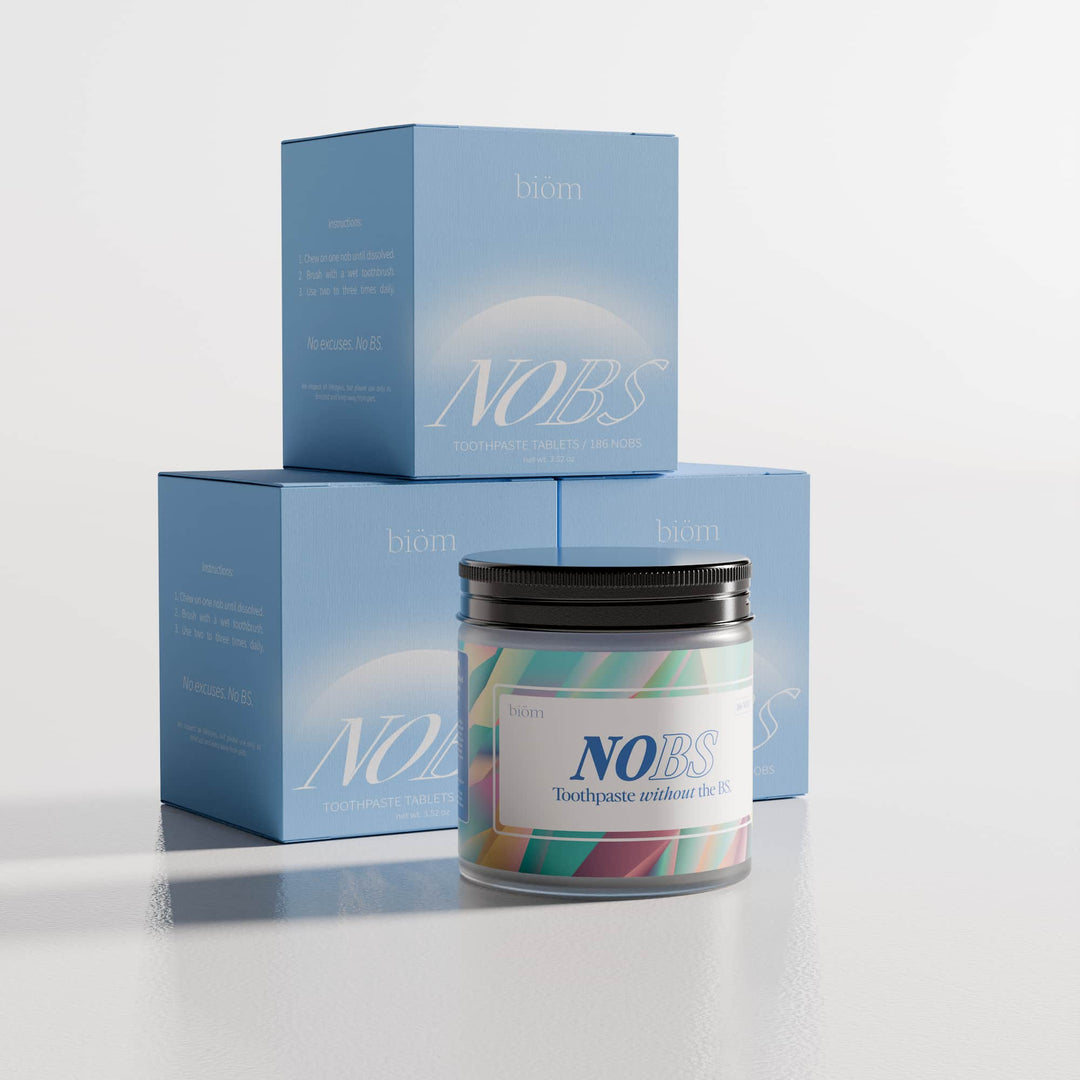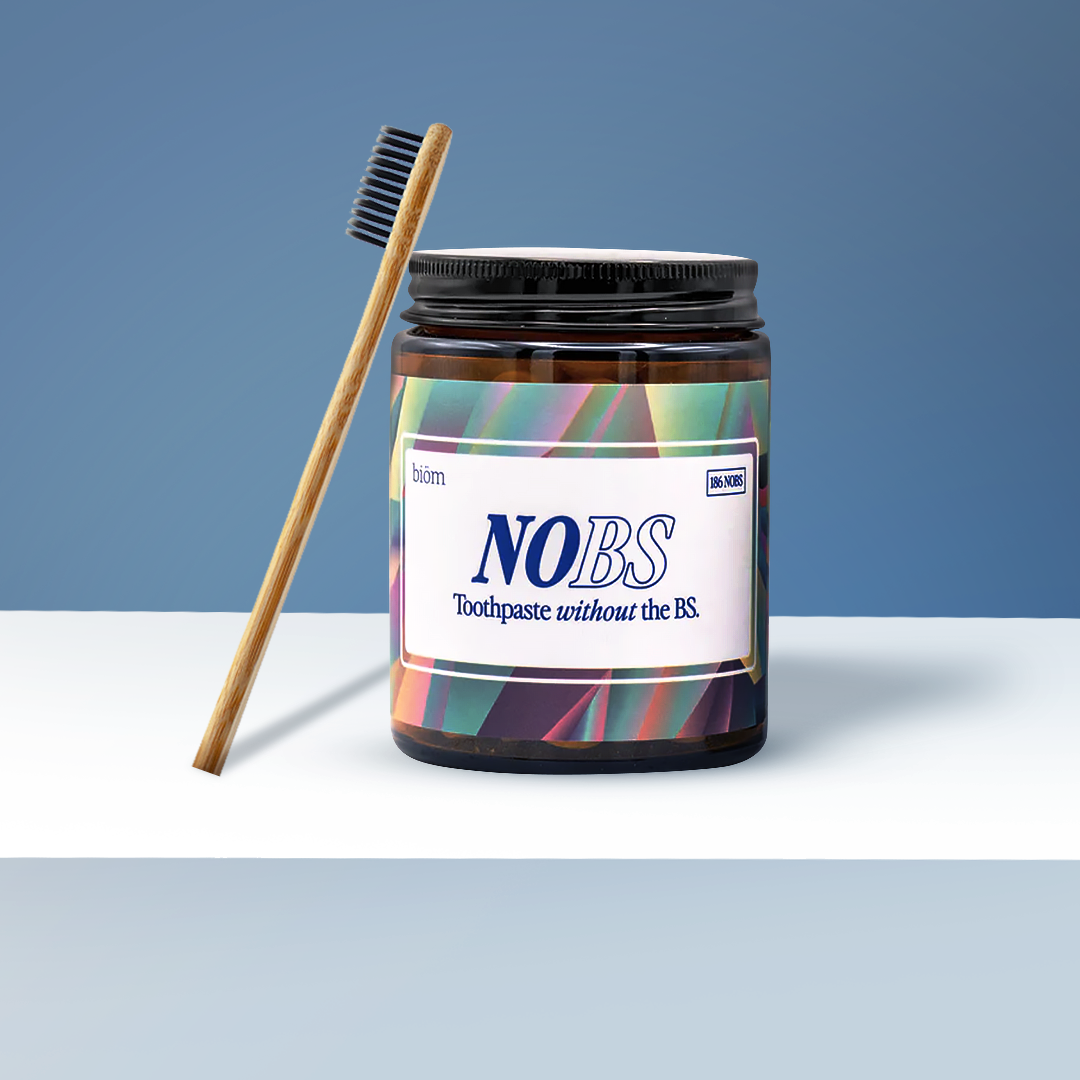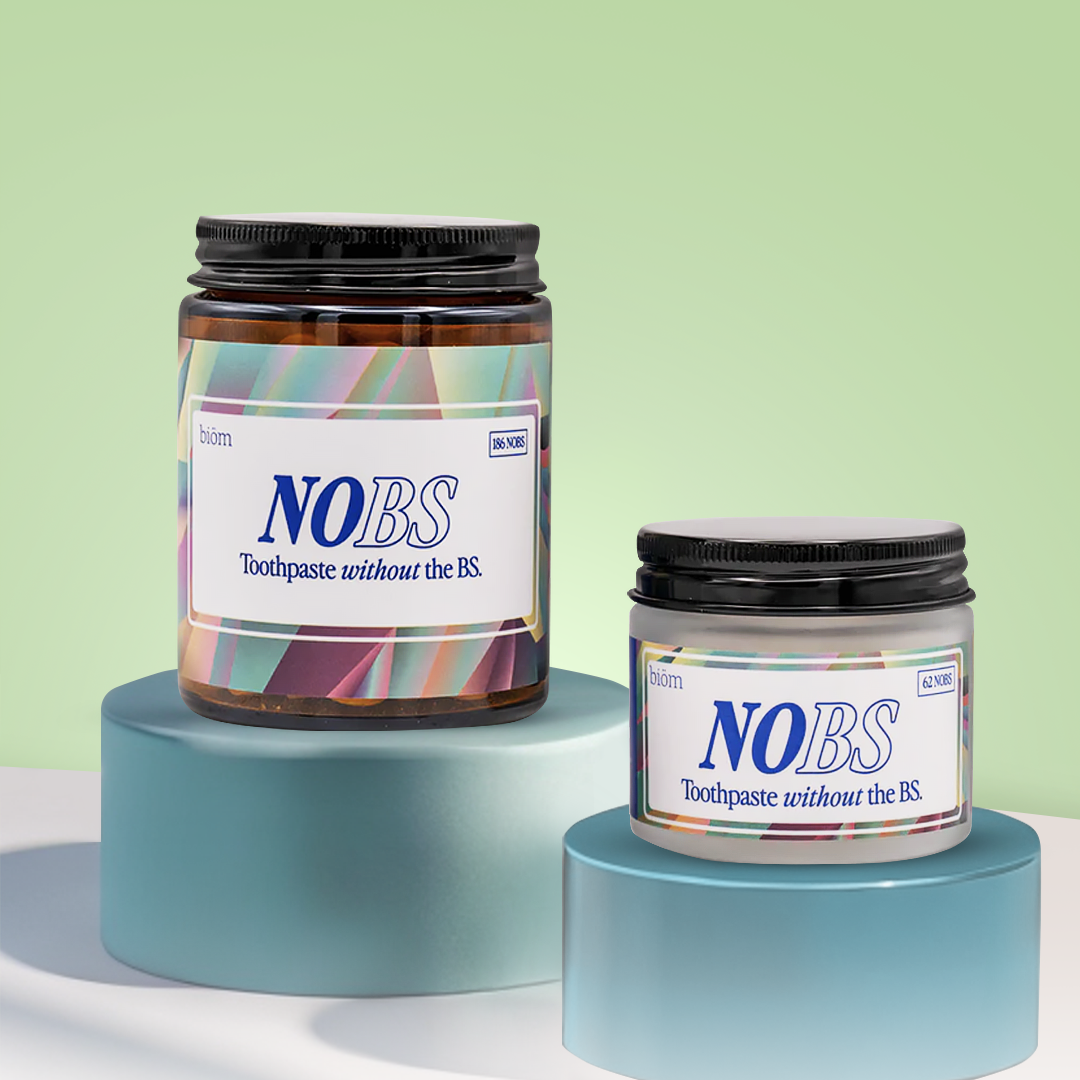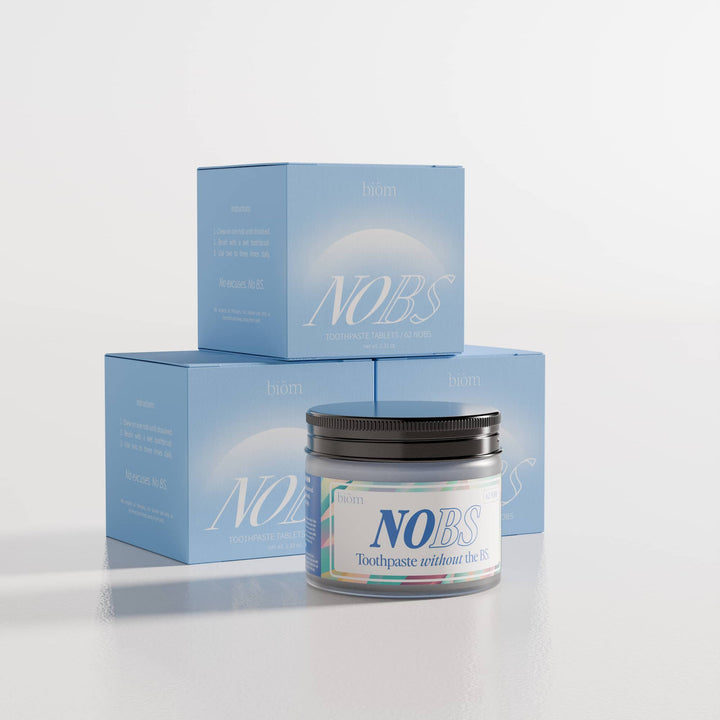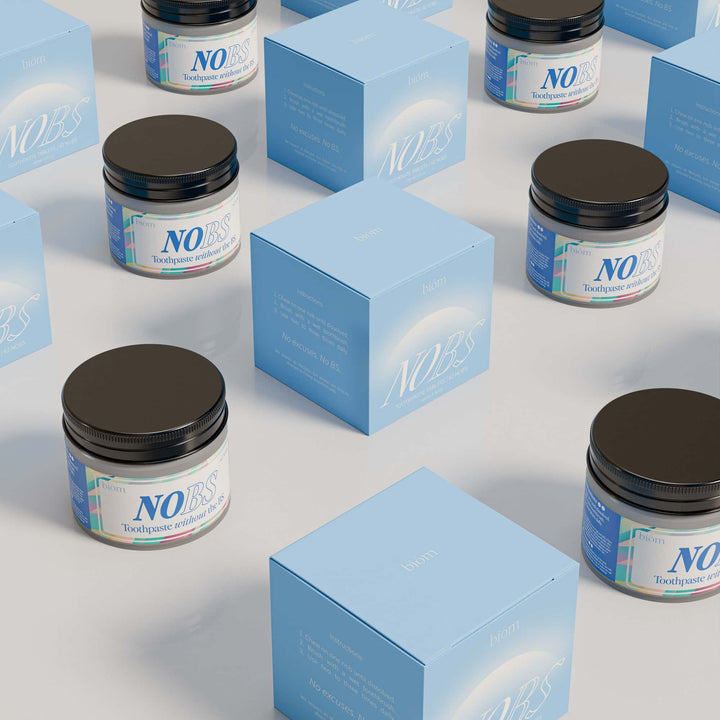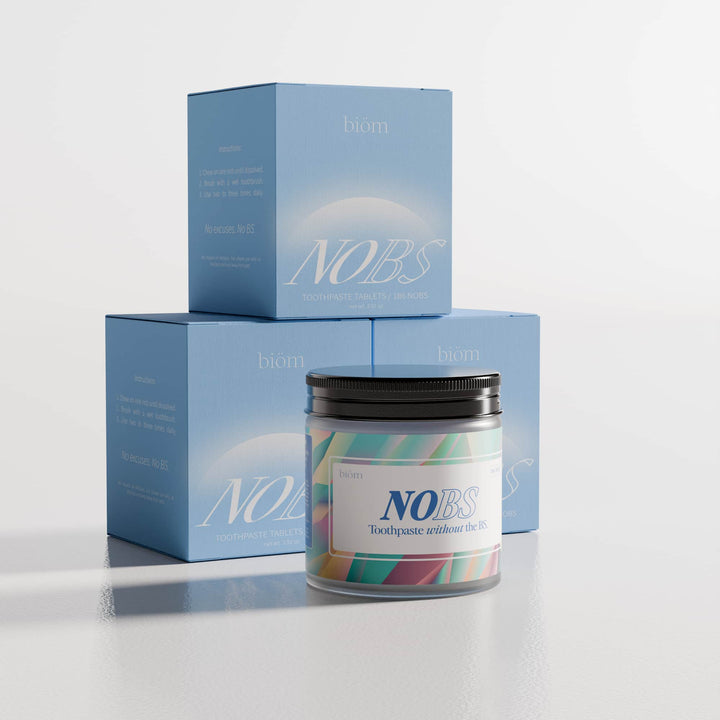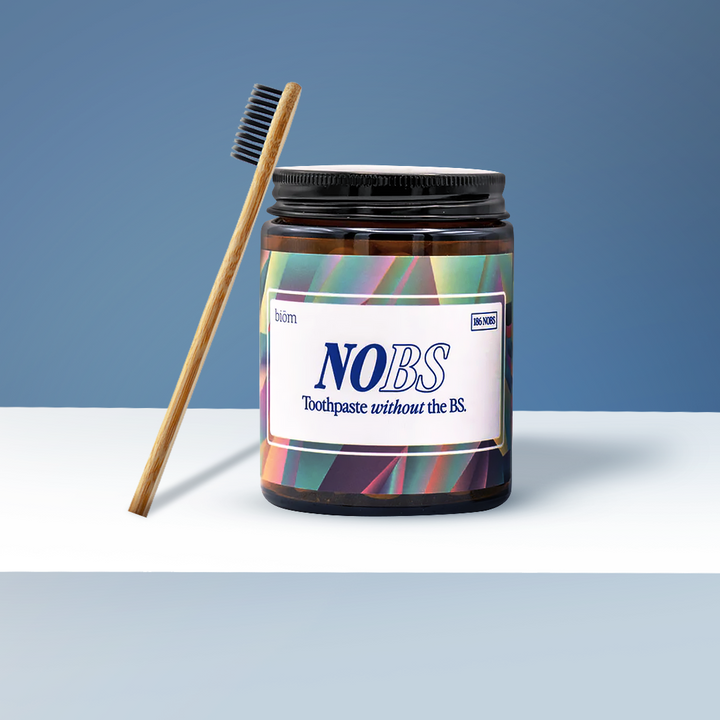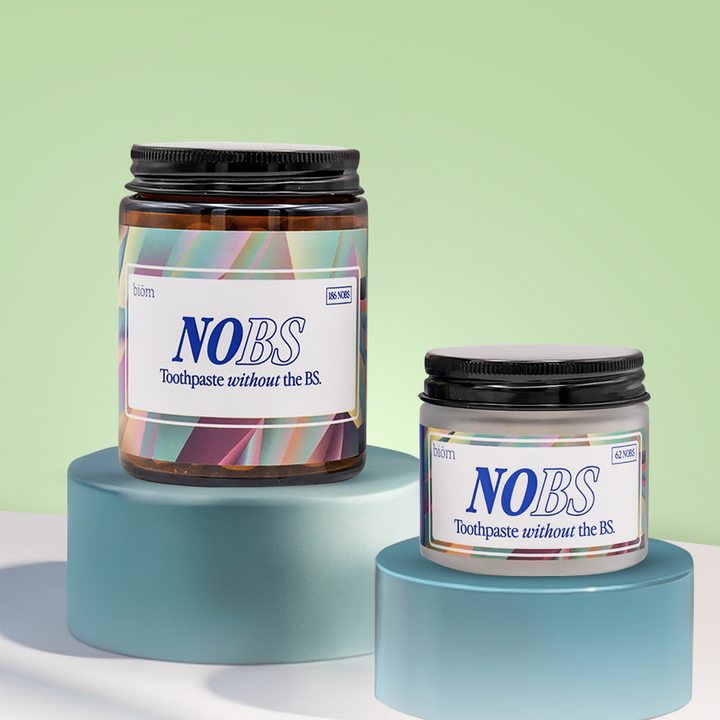What is Hydroxyapatite Used For?
Hydroxyapatite has many applications in dentistry and regenerative medicine, including:
-
use in toothpaste to remineralize enamel and reverse tooth decay
-
use in orthopedic implants and bone grants to support biocompatibility and speed up wound healing
-
use in cosmetics to improve texture and create unique matte finishes
These diverse applications showcase the versatility of hydroxyapatite in improving health, aesthetics, and materials in various fields. That said, of all of these, hydroxyapatite is most well known for its application in remineralizing toothpaste.
In this article, I'll explain everything you need to know about the many applications of hydroxyapatite and what we use it in toothpaste.
What is hydroxyapatite?

Hydroxyapatite (also referred to as simply "HA") is a naturally occurring mineral that is the primary inorganic component of human teeth and bones.
It is a crystalline structure composed of calcium and phosphate ions, making it a vital component of the hard tissues in our bodies. In fact, hydroxyapatite gives our teeth and bones their strength and hardness.
In the context of teeth, hydroxyapatite is a key component of tooth enamel, which is the outermost layer of the tooth surface. Enamel is the hardest substance in the human body, and it protects the underlying dentin and pulp of the tooth.
Hydroxyapatite is also used in various dental and medical applications, including dental implants, bone grafts, and as a biomaterial in orthopedic surgery.
What is hydroxyapatite toothpaste?
Hydroxyapatite toothpaste is a relatively new type of toothpaste that is gaining popularity due to its potential benefits for oral health.
It contains hydroxyapatite or nano hydroxyapatite (nHa), a naturally occurring mineral that makes up 97% of tooth enamel and 60% of tooth dentin.
Unlike fluoride toothpaste, nano hydroxyapatite is a natural substance already found in your teeth and bones. These hydroxyapatite toothpastes work by depositing calcium phosphate ions back into your tooth surface where research has shown that it can help strengthen and remineralize teeth, making it a promising option for dental care.
Hydroxyapatite toothpaste is often fluoride-free and is considered a better alternative to fluoride for maintaining oral health, particularly for individuals with sensitive teeth, and pregnant women.
This is because nano hydroxyapatite does not exhibit negative effects like fluoride toxicity and is safe to be used by children and pregnant women.
How does hydroxyapatite work?
Because it is made of the same materials as your teeth, calcium phosphates, hydroxyapatite toothpaste works to prevent tooth decay by filling in your enamel with calcium and phosphate to restore and strengthen your teeth.
While you cannot remineralize a cavity once it has formed, evidence does suggest that nano hydroxyapatite can remineralize initial carious lesions which many dentists agree are closer to tooth decay than actual cavities.
A standard diet high in acid and sugar will slowly eat away at your enamel. Without intervention, your enamel erodes, and cavities form. Dental experts use nano hydroxyapatite paste to deliver hydroxyapatite crystals into the teeth, prevent this erosion, and to improve your oral health overall.
Now that we understand how hydroxyapatite toothpaste works, let's walk through some of its other uses and applications.
Dental Implants
Hydroxyapatite is used in dental implants to improve their integration with the surrounding bone tissue in a process known as osseointegration.
Dental implants are sort of like artificial teeth that get surgically placed in the jawbone. Typically, they're used to support other dental treatments like crowns.
When researchers apply hydroxyapatite coatings to the implant surface, the implant is better able to mimic the natural composition of our bones. This improves the implant's biocompatibility and reduces the risk of adverse reactions, like inflammation.
Further, research suggests that hydroxyapatite coatings on dental implants promote faster healing, reduce recovery time, and increase the longevity of dental implants.
Orthopedic Implants
Did you know hydroxyapatite is widely used in orthopedic implants, particularly in procedures involving joint replacements such as hip and knee replacements?
In these orthopedic surgeries, the goal is to replace damaged or arthritic joints with artificial implants that can replicate the natural joint's functions. Scientists apply hydroxyapatite coatings to the surface of these implants to facilitate their integration with the patient's existing bone tissue.
Similar its use with dental implants, the biocompatible nature of hydroxyapatite ensures that it is well-tolerated by the body and does not trigger adverse reactions.
Further, evidence suggests the presence of hydroxyapatite on orthopedic implants enhances the bond between the implant and the adjacent bone, promoting secure fixation. This reduces the risk of implant loosening or migration, which can lead to implant failure and the need for revision surgery.
Bone Grafts
Bone grafts are used in bone tissue engineering to replace missing bone tissue or for bone regeneration due to injuries, diseases, or surgeries.
Hydroxyapatite, in the form of granules, powders, or porous scaffolds, is often used as a bone graft material. This is because hydroxyapatite's natural composition is similar to human bone, making it an ideal choice for promoting bone tissue regeneration in the following ways:
-
providing a scaffolding for new bone formation
-
allow bone cells to attach and proliferate
-
and facilitating the growth of new bone tissue.
Further, because hydroxyapatite is a biomimetic substance, it's well-tolerated and unlikely to cause any adverse reactions during bone repair.
Coatings for Medical Devices
As alluded to in earlier sections, hydroxyapatite coatings are used on a wide range of medical devices, including screws, plates, pins, and prosthetic components, to enhance their biocompatibility and performance.
Not only does hydroxyapatite enhance the biocompatibility of medical devices, but it can also facilitate the bonding of the implant with the surrounding bone tissue. This strong connection ensures the stability and longevity of the implant and it reduces the likelihood of an implant failure (or other complication) over time.
Dental Fillers
When teeth develop cavities or suffer from enamel defects due to decay or wear, dentists use dental fillers to fill in these areas. Essentially, these fillers restores the tooth's structure and function.
In particular, hydroxyapatite-based dental fillers are valued for their biocompatibility and ability to mimic the natural mineral composition of teeth (think calcium phosphate). This makes them an excellent choice for dental restorations as they are well-tolerated by the body and closely resemble our natural human tooth structure.
Bioactive Glass
Bioactive glass is a type of synthetic glass material that has the ability to bond with living tissues. Understandably, it's an excellent choice for various medical and dental applications.
Hydroxyapatite is often incorporated into bioactive glass formulations to enhance its biocompatibility and bone-regenerating properties. Research suggests that when used in tissue engineering and regenerative medicine, hydroxyapatite-containing bioactive glass serves as a scaffold for new bone formation.
Cosmetic Dentistry
In cosmetic dentistry, hydroxyapatite plays a significant role in improving the aesthetics, health, and appearance of teeth.
Cosmetic dentists may use hydroxyapatite-based materials for various procedures aimed at enhancing smiles and addressing common aesthetic concerns:
-
Tooth Bonding: Hydroxyapatite can be used as a dental bonding material to repair chipped or cracked teeth. Cosmetic dentists apply a tooth-colored resin containing hydroxyapatite to the affected tooth, sculpting it to match the natural tooth shape.
-
Tooth Whitening: Hydroxyapatite is sometimes incorporated into tooth whitening treatments. It can help remove surface stains and discolorations, contributing to a brighter and more radiant smile.
-
Veneers: Hydroxyapatite-based materials are used to create dental veneers, thin shells that are custom-made to fit over the front surface of teeth. Veneers can mask imperfections such as stains, gaps, and misaligned teeth, providing patients with a more attractive smile.
-
Composite Fillings: Some modern composite dental fillings contain hydroxyapatite. These fillings are not only functional but also blend seamlessly with the natural tooth color, ensuring a more aesthetically pleasing result.
Plus, nano hydroxyapatite toothpaste tablets are an effective tool to prevent tooth decay, soothe hypersensitivity, and whiten teeth.
Research and Development
Hydroxyapatite is a critical material in R&D efforts focused on biomaterials, medical devices, and tissue engineering. Researchers rely on hydroxyapatite to develop and refine innovative solutions in orthopedics, dentistry, and regenerative medicine.
Its natural resemblance to bone mineral makes it an invaluable component for creating novel materials that can interact seamlessly with the human body. In orthopedics, for instance, R&D teams work on enhancing the performance of joint implants by incorporating hydroxyapatite coatings to improve osseointegration and reduce implant failure rates.
In dental research, hydroxyapatite is explored for its potential to revolutionize restorative dentistry. Scientists are investigating new formulations of dental fillers and materials containing hydroxyapatite that can not only repair damaged teeth but also actively promote remineralization.
Additionally, in the broader field of regenerative medicine, researchers are using hydroxyapatite-based scaffolds for tissue engineering, creating artificial bone structures that can be implanted to replace damaged or lost bone tissue.
Orthodontic Brackets
In addition to regenerative dentistry, hydroxyapatite is also used in orthodontics. Orthodontic brackets are components of braces that get attached to the teeth and hold the arch wires, supporting the alignment of teeth throughout the treatment.
Essentially, orthodontists incorporate hydroxyapatite into these brackets for two reasons:
-
It helps reduce the risk of enamel demineralization which is common during braces treatments.
-
It enhances the biocompatibility of orthodontic brackets which is essential to avoid adverse reactions.
Basically, the presence of hydroxyapatite on the brackets releases calcium and phosphate ions, strengthening the enamel underneath the bracket and preventing demineralization and side effects.
This ensures that patients experience less discomfort during orthodontic treatments.
Toothpaste and Oral Care Products

Of course, we have to talk about hydroxyapatite in toothpaste and other oral care products! Because hydroxyapatite closely mimics the natural composition of our teeth, it's an ideal agent for promoting remineralization.
Thus, hydroxyapatite toothpaste can deposit calcium and phosphate back into our teeth which helps restore enamel that is under constant attack of demineralization from the acids produced by our naturally occurring oral bacteria or our diets.
Through the remineralization process, hydroxyapatite toothpaste:
-
protects against tooth decay
-
reduces sensitivity
-
and whitens teeth.
Beyond toothpaste, hydroxyapatite is also used in mouthwash, dental gels, and even chewing gum. IN these products, it serves similar benefits as it does it toothpaste.
So, why is hydroxyapatite in toothpaste?
Hydroxyapatite is primarily included in toothpaste for its remineralization ability. In toothpaste, hydroxyapatite particles restore and strengthen our tooth enamel by depositing calcium and phosphate ions.
You see, when our enamel is exposed to acids produced by the bacteria that naturally live in our mouths or dietary acids/sugars, it can become demineralized. This leads to weakened enamel, tooth sensitivity, and tooth decay. If left untreated, that tooth decay can progress into full blown dental caries.
Since hydroxyapatite is a biomimetic compound and closely mimics the natural mineral composition of our teeth, it is easily able to remineralize enamel and protect us from all kinds of dental issues.
Studies also show that hydroxyapatite toothpaste can prevent plaque buildup which can otherwise lead to tartar development and cavities. Further, more research suggests that hydroxyapatite can also whiten teeth as the remineralization process may remove surface stains.
What's the difference between hydroxyapatite and nano hydroxyapatite?
Nano hydroxyapatite (nano-HA) and hydroxyapatite (HA) are both forms of the mineral hydroxyapatite, but they differ in terms of particle size, applications, and properties.
Let's walk through some of the main differences between hydroxyapatite vs nano hydroxyapatite.
Natural vs. Synthetic
First, the nano hydroxyapatite in your toothpaste is likely synthetic nHA that was created in a laboratory through controlled chemical processes. While that may seem scary, don't worry - nano hydroxyapatite is safe and effective.
Hydroxyapatite can also be found naturally in human teeth and bones. Natural sources include animal-derived hydroxyapatite from sources like bovine bone or fish scales. Similarly, synthetic hydroxyapatite is produced for various applications, including dental and medical uses.
Particle Size
Nano hydroxyapatite consists of nanoscale particles, typically with dimensions in the range of tens to hundreds of nanometers. Its small particle size allows for greater surface area and improved bioavailability.
This is why nano hydroxyapatite particles can be so advantageous in regenerative dentistry.
On the other hand, traditional hydroxyapatite consists of much larger particles than nano sized particles, typically in the micrometer range. While hydroxyapatite is still a fine powder, it does have a lower surface area compared to nano hydroxyapatite.
This is why hydroxyapatite toothpastes tend to be less effective than nano hydroxyapatite toothpastes.
Biocompatibility
Both nano hydroxyapatite and hydroxyapatite are safe and biocompatible substances and closely resemble the natural mineral composition of our teeth and bones.
Applications
Nano hydroxyapatite is most popular for its use in dental products, thanks to its benefits of oral biofilm management, preventing tooth decay, and soothing hypersensitivity. This is because it has a particularly small particle size which allows it to penetrate and remineralize tooth enamel effectively.
Similarly, hydroxyapatite is also used in dentistry but not as commonly as nano hydroxyapatite.
Both nHA and HA have a broad application range, including:
-
orthopedic and dental implants
-
bone grafts
-
and other various medical applications.
In particular, dental professionals use nano hydroxyapatite toothpaste as a better alternative to fluoride.
Remineralizing Properties
Nano hydroxyapatite is well-known for its remineralizing properties. In fact, it's one of the best treatments for tooth decay and sensitivity. While hydroxyapatite toothpaste can also be effective for remineralization, studies suggest that it is not as effective as nano hydroxyapatite toothpaste.
Aesthetic Benefits
Nano hydroxyapatite is known for its ability to improve your smile, including benefits like:
-
whitening teeth
-
reducing discoloration
-
and improving the glossiness and hardness of teeth.
In contrast, research suggests hydroxyapatite toothpaste may not be as effective as nano hydroxyapatite toothpaste in providing these aesthetic benefits.
Safety
Because of their biomimetic nature, both nano hydroxyapatite and hydroxyapatite are generally considered safe for various applications, including use in toothpaste.
In particular, experts suggest that nano hydroxyapatite has low toxicity and minimal risk of adverse effects.
Is hydroxyapatite better than fluoride?

Yes, nano hydroxyapatite can be considered better than fluoride as it offers similar benefits without the associated toxicity.
It provides the advantages of fluoride, such as enamel protection, sensitivity reduction, and remineralization, but without the potential harm linked to fluoride ingestion. For example, research suggests that nano hydroxyapatite is non-toxic and safe enough to swallow, unlike fluoride which can cause dental and skeletal fluorosis if overexposed.
That's why we recommend choosing fluoride free toothpaste with nano hydroxyapatite - it can be a safer and better alternative for oral care. That said, you can always choose to use nano hydroxyapatite and fluoride together in your oral care routine.
Is hydroxyapatite toothpaste safe for kids?
Yes, hydroxyapatite toothpaste is safe for kids. In fact, in comparing hydroxyapatite vs fluoride, it may be the more suitable choice as experts suggest that hydroxyapatite is safe to swallow.
Hydroxyapatite is well-tolerated by people of all ages as it is closely mimics the natural mineral composition of our teeth, and it is unlikely to cause any adverse reactions. One paper from 2022 even states, "Thus far in the literature, there have been no reports of adverse dental or systemic effects of HAP-containing toothpastes because HAP has an excellent biocompatibility."
Of course, even though kids hydroxyapatite toothpaste is safe to swallow, parents should still supervise their children as they're learning to brush.
Summary: Use of Hydroxyapatite

Hydroxyapatite, a calcium phosphate mineral, is used extensively across many different fields of regenerative medicine due to its unique biometric properties.
For example, in oral care, we use hydroxyapatite to reverse demineralization, strengthen weakened enamel, and prevent tooth decay. Further, hydroxyapatite is often used in orthopedics and bone tissue engineering to enhance the biocompatibility of various implants thanks to its ability to facilitate a strong bond between the implant and surrounding bone tissue.
Of all of these applications, the most popular is the use of hydroxyapatite and nano hydroxyapatite in remineralizing toothpaste for its abilities to soothe hypersensitivity, strengthen enamel, and whiten teeth.
Frequently Asked Questions
What does hydroxyapatite do for the body?
Hydroxyapatite, a calcium phosphate mineral, is integral to the body's skeletal and dental systems. It forms the structural basis of bones and teeth, providing the hardness and density essential for support and protection. In teeth, hydroxyapatite constitutes the majority of tooth enamel, protecting teeth from damage and decay. It also stimulates remineralization, aiding in enamel repair and cavity prevention. Its biocompatibility makes it suitable for use in medical implants, dental materials, and bone grafts, where it enhances integration with surrounding tissues. Additionally, hydroxyapatite serves as a scaffold for bone regeneration, facilitating healing and growth in cases of bone loss or damage.
What are the disadvantages of hydroxyapatite?
There are no known disadvantages or side effects of nano hydroxyapatite in toothpaste. Research states that there is no literature reporting any systemic or adverse effects of hydroxyapatite containing toothpastes. In fact, that's why many people are turning to nano hydroxyapatite toothpaste as a safe, non-toxic alternative to fluoride toothpaste.
What are the concerns with hydroxyapatite?
There are no concerns with hydroxyapatite. In fact, there are no known disadvantages or side effects of nano hydroxyapatite in toothpaste. Research states that there is no literature reporting any systemic or adverse effects of hydroxyapatite containing toothpastes. That's why many people are turning to nano hydroxyapatite toothpaste as a safe, non-toxic alternative to fluoride toothpaste.
What are the medical applications of hydroxyapatite?
Hydroxyapatite is commonly used as a coating for orthopedic and dental implants to enhance biocompatibility as well as improve implant stability and longevity. Hydroxyapatite is also used as a bone graft material to stimulate bone regeneration in cases of bone loss or damage, speeding up the healing process. In addition to its orthopedic and dental uses, hydroxyapatite is used in bone tissue engineering to create scaffolds for regenerating bone and other tissues.
What do dentists think about hydroxyapatite?
Dentists view hydroxyapatite positively, especially in its application within oral care products and dental treatments. Hydroxyapatite's biometric nature and natural resemblance to tooth enamel makes it a valuable ingredient in toothpaste and dental materials. It is effective in promoting enamel remineralization, reducing tooth sensitivity, and aiding in cavity prevention.


